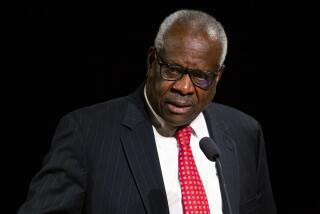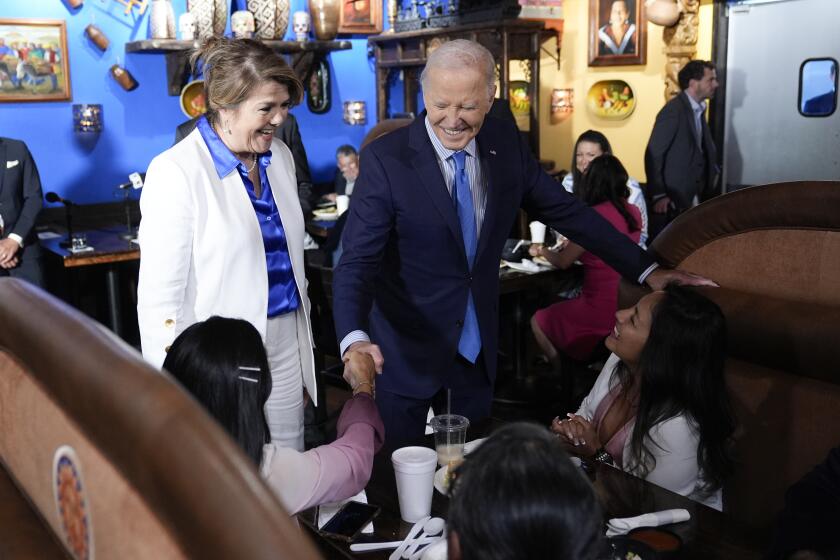Stem cell agency’s top salaries stand out on state roster
California’s stem cell research agency says it needs billions more taxpayer dollars to deliver on promised cures to major diseases. Yet at a time when other departments are cutting back spending, the agency recently agreed to pay its new boss one of the highest salaries in state government.
The 50-person grant-making body will pay a Los Angeles investment banker $400,000 to serve as its new part-time board chairman, pushing the combined salaries of its two top officials to nearly $1 million per year.
Santa Monica-based Saybrook Capital founder Jonathan Thomas — chosen over a former cardiologist who was willing to take the job for less than half the salary — said his pay is “reasonable” because he has the background to help the agency raise the money it needs to survive. “Without funding, everything else suffers,” Thomas said.
Voters approved a $3-billion ballot measure establishing the California Institute for Regenerative Medicine in 2004. In a high-profile campaign, proponents argued that embryonic stem cell research held the key to curing cancer, Alzheimer’s, spinal cord injuries and other maladies.
More than $1 billion has already been awarded as grants or spent on agency operations, and scientists say possible cures are years if not decades away, given the painfully slow progress of medical exploration. Now, institute officials acknowledge that they plan to ask voters for at least another $3 billion in the next few years to keep the agency going.
The institute’s operating expenses are capped at 6% of its total funding. For 2010-11, it earmarked $16 million for operating expenses, according to budget reports.
Critics say lavish spending on salaries, including last month’s generous deal with Thomas, could work against the agency in a future ballot campaign.
“This salary will give their opponents a lot of ammunition,” said John Simpson of the Santa Monica-based group Consumer Watchdog. “It will haunt them.”
The other finalist for the chairman’s job was Frank Litvack, a former Cedars-Sinai Medical Center cardiologist and a medical device entrepreneur. Litvack has a record of steering medical start-ups through the regulatory and financial maze, according to his resume.
Litvack was also willing to serve as the institute’s part-time chairman for $123,000 a year, the bottom of the job’s pay range, said agency spokesman Don Gibbons.
Thomas won a 14-11 vote of the agency’s board of directors after getting letters of support from Gov. Jerry Brown, Lt. Gov. Gavin Newsom and state Treasurer Bill Lockyer, all of whom are Democrats.
Lockyer spokesman Tom Dresslar called Thomas, whose resume shows he received a bachelor’s degree in biology, a doctorate in history from Oxford and a Yale law degree, a well-rounded candidate. “Folks can quibble about the salary; we’re not interested in getting into that fight,” Dresslar said.
Controller John Chiang, also a Democrat, was the lone statewide elected official who supported Litvack. His reason was simple. The Los Angeles doctor “is grounded in such a strong sense of civic duty and belief in CIRM’s mission of saving lives that he will serve in the position at the lowest salary being offered,” Chiang wrote in his nomination letter.
The stem cell agency, which set up shop in a trendy office across the street from AT&T Park in San Francisco, started drawing scrutiny — some say envy — from leaders in Sacramento almost from the start.
Legislators and government watchdogs criticized the program for paying its president more than twice the governor’s salary, distributing nearly $1 billion to universities with representatives on its board of directors and overselling the promise of stem cell cures.
Last year, the agency paid a consortium of scientists to review the institute’s progress so far. The report was glowing, and outgoing board Chairman Robert Klein, a Silicon Valley real estate investor who led the initiative campaign in 2004 and is sensitive to criticism of the agency he created, tried to hire the report’s lead author as his replacement.
But state leaders, including Lockyer, balked at that prospect, and the job remained open.
With his $400,008 salary, Thomas joins institute President Alan Trounson — who made $490,008 last year — high on the list of the state’s top paid, non-university employees. Others at the top, with 2010 pay ranging from $374,000 to $785,000, include prison doctors or executives for the workers’ compensation fund or the pension system.
The list, provided by the controller’s office, does not include university employees, some of whose salaries can reach seven figures.
“I think this is just an incredibly politically tone-deaf move at a time when the state is struggling to keep its head above water,” Simpson said.
Ex-state senator and former Democratic Party Chairman Art Torres, who was hired in 2009 to help defend against some of the political criticism, makes $230,000 per year as one of the institute’s vice chairmen.
By contrast, Gov. Jerry Brown makes $173,048. The director of the National Institutes of Health, which employs more than 17,000 people and invests $32.5 billion in medical research each year, makes $199,700.
Thomas, who took the job with the understanding that it would consume 80% of his work time, said the pay is “reasonable,” especially “when you factor in the work load as I intend to carry it out.”
He said as much as $250,000 of his salary would come from charitable contributions received by the agency.
In a written statement to the board after his election, Thomas told his new colleagues they were in a “communications war” in which “the world seems to be focused on internal issues instead of the grand big picture” of the institute’s mission to cure disease.
His solution? In late June the agency posted an ad for a new public relations director who will make as much as $208,520 per year.
More to Read
Start your day right
Sign up for Essential California for news, features and recommendations from the L.A. Times and beyond in your inbox six days a week.
You may occasionally receive promotional content from the Los Angeles Times.







